写作课讲义 5
- 格式:ppt
- 大小:35.00 KB
- 文档页数:6
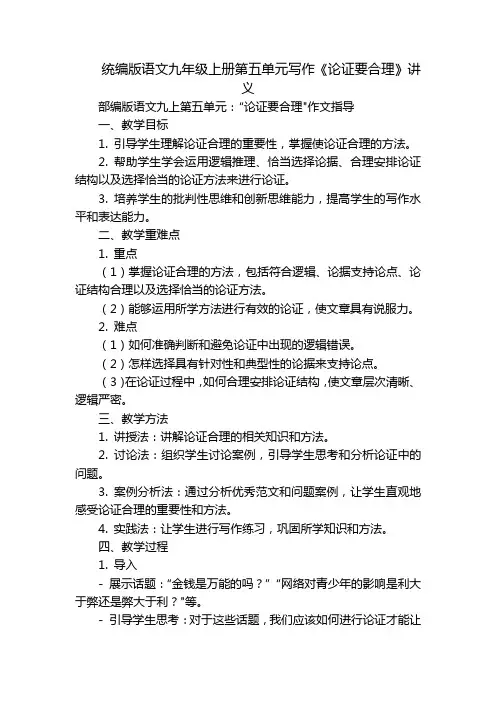
统编版语文九年级上册第五单元写作《论证要合理》讲义部编版语文九上第五单元:“论证要合理"作文指导一、教学目标1. 引导学生理解论证合理的重要性,掌握使论证合理的方法。
2. 帮助学生学会运用逻辑推理、恰当选择论据、合理安排论证结构以及选择恰当的论证方法来进行论证。
3. 培养学生的批判性思维和创新思维能力,提高学生的写作水平和表达能力。
二、教学重难点1. 重点(1)掌握论证合理的方法,包括符合逻辑、论据支持论点、论证结构合理以及选择恰当的论证方法。
(2)能够运用所学方法进行有效的论证,使文章具有说服力。
2. 难点(1)如何准确判断和避免论证中出现的逻辑错误。
(2)怎样选择具有针对性和典型性的论据来支持论点。
(3)在论证过程中,如何合理安排论证结构,使文章层次清晰、逻辑严密。
三、教学方法1. 讲授法:讲解论证合理的相关知识和方法。
2. 讨论法:组织学生讨论案例,引导学生思考和分析论证中的问题。
3. 案例分析法:通过分析优秀范文和问题案例,让学生直观地感受论证合理的重要性和方法。
4. 实践法:让学生进行写作练习,巩固所学知识和方法。
四、教学过程1. 导入- 展示话题:“金钱是万能的吗?”“网络对青少年的影响是利大于弊还是弊大于利?"等。
- 引导学生思考:对于这些话题,我们应该如何进行论证才能让别人信服?- 引出本节课的主题:论证要合理。
2. 讲解论证合理的重要性- 讲解:论证是议论文的核心,它通过逻辑推理和事实论据来支持作者的观点。
一个合理的论证能够使观点更有说服力,让读者更容易接受。
- 举例:如果有人说“因为天空是蓝色的,所以所有的花朵都是红色的”,这样的论证显然是不合理的,因为天空的颜色与花朵的颜色之间没有必然的联系。
- 强调:不合理的论证会导致文章缺乏可信度,无法达到说服读者的目的。
3. 论证要符合逻辑- 观点一致:确保论点在论证过程中保持一致,不出现前后矛盾或偏离主题的情况。
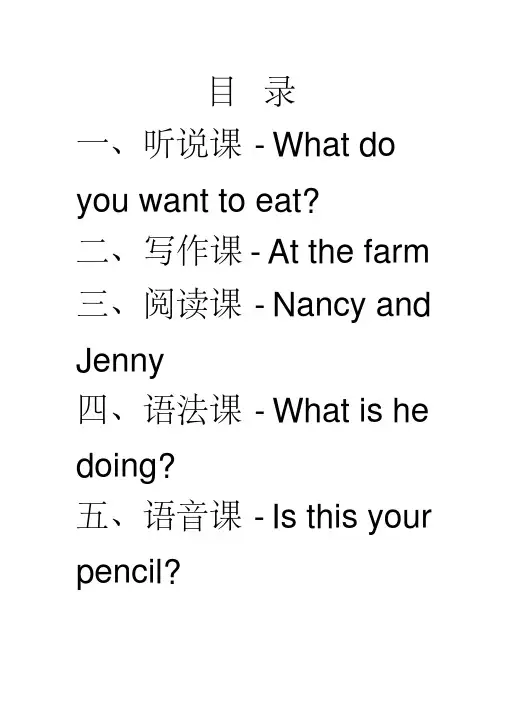
目录一、听说课-What do you want to eat?二、写作课-At the farm三、阅读课-Nancy and Jenny四、语法课-What is he doing?五、语音课-Is this your pencil?一、听说课-What do youwant to eat?1.题目:What do you want to eat?2.内容:food: ice cream, milk, cake, hamburger, pizza, hot dogA:What do you want to eat?B:I want ice cream, of course.3.基本要求:(1)全英授课(2)培养学生的口语能力,体现学生的互动性教案What do you want to eat?Teaching PlanI Teaching AimsKnowledge aims1. Students can understand the meaning of the new words, such as i ce cream, cake, hamburger and so on.2. Students can use the sentence pattern to express the food they like to eat.Ability aimThrough different activities, students can improve their listening and speaking ability.Emotional aimStudents will be confident to communicate with others in English and can cooperate with others in groupwork.II Teaching Key &Difficult PointsKey point: students can master the meaning of new words as well as sentence patterns. Difficult point: students can express the topic about food in their daily life.IIITeaching procedures:Step 1: Warming upSing a chant namedtomato with students together, the content is as follow:Tomato tomato wash washwash;Tomato tomato cut cutcut;Tomato tomato cook cookcook;Tomato tomato eat eateat;Step 2: Presentation1.Show some pictures about food, then present the new words: ice cream, milk, cake, hamburger, pizza,hot dog;2. Teacher read the words one time and students read them three times;3. Play a word game named show and say, students are divided into two groups, when teacher showstudents one picture, they should say according word, the faster group will be awarded withmore stars.Step 3: Practice1. Listen to the tape and then answer questionsabout what does B and A want to eat;2. Play a game “Hot potato” to ask Ss what do they want to eat.Step 4: ProductionStudents are required to do a pair work, one actas a waiter, and the other act as customer, thenmake anew conversation with the topic about food,and then perform it in front of the class.Step 5: Summary & HomeworkAsk students to say what they have got one byone.Students share what they like to eat to theirfamily members.IVBlackboard design二、写作课-At the farm1. 题目:At the farm2.内容:3.基本要求:(1)讲解写作(2)设计相应的教学活动(3)全英文授课教案At the farmTeaching PlanI Teaching AimsKnowledge aimStudents can read and write some words related to vegetables and animals correctly.Ability aimStudents can make connection between English words and real objects and will develop their writingability.Emotional aimStudents can find the beauty in English and foster a good habit of writing English.II Teaching Key &Difficult PointsKey point: Students can read and write some words related to vegetables and animals correctly.Difficult point: Students can make connection between English words and real objects and will developtheir writing ability.IIITeaching procedures:Step 1: Warming upGreet students. Ask them what did they so during weekends. Sing the song “old MacDonald’s farm”, thenlead in this lesson “At the farm” Step 2: Presentation&Practice1. Set up a situation that is on Mr. MacDonaldfarm, draw some pictures on the blackboardand then askstudents what they are to present differentwords related to vegetables and animals in thisclass.2. Show the picture of the farm and studentsfind out the animals and vegetables that theysee.Then let students look around the classroom.Say some sentences with the structure “the eare…”“thosare...” Step 3: Production1. Students write down their description byusing the sentence: These are.../Thoseare…about the thingsthey can see in the classroom.2. Students share their answers in the class, and teacher checks their writing and correctmistakes.3. Teacher write a right sentence on the blackboard and tell students the rule to write English sentences.Step 4: Summary & HomeworkAsk students what they have learnt in this class. Homework: share their writing with theirparents and i n troduce Mr. MacDonald’s farm to them.IVBlackboard design三、阅读课-Nancy andJenny1.题目:Nancy and Jenny2.内容:Nancy and Jenny are twin sisters. They looklike each other. Jenny’s hair is longer than Nancy’s hair.Nancy is taller than Jenny. They like running.But Nancy runs faster than Jenny. They alsolike singing.Jenny sings better Nancy. Nancy is quieter than Jenny. Jenny is smarter than Nancy. Their bagsare black.Nancy’s bag is bigger than Jenny’s bag.3.基本要求:(1)让学生读懂并理解这篇课文(2)讲解阅读技巧教案Nancy and JennyTeaching PlanI Teaching AimsKnowledge aimsStudents can understand this short passage and master some expressions about comparative degree.Ability aimsStudents will improve their reading efficiency and reading ability.Emotional aimStudents are willing to read a lot of English reading materials in their daily life.II Teaching Key &Difficult PointsKey point: Students can understand this short passage and master some expressions about comparativedegree.Difficult point: foster good habit of reading English materials in their daily life.IIITeaching procedures:Step 1: Warming upShow two pictures of Jenny and Nancy, ask students what do they find then share their answer with eachother.Step 2: PresentationRead the short passage for the first time and they need to read it as fast as the can, ask them what is themain idea of this passage and students share answers.Students read the passage for the second time and ask them to find what are the different characteristicsmentioned in the passage? Then find the exact answers. eg. Whose hair is longer?Step 3: PracticeSs do a role play. They can play Nancy or Jenny and do a self introduction.Step 4: ProductionDraw a picture of best friend and describe she/ he in Ss’ own words. Invite some students to be the story teller to introduce his or her friends.Step 5: Summary & HomeworkStudents look at the blackboard and summarize this class, and the homework is that students introduceJenny and Nancy to their friends or parents. IVBlackboard design四、语法课-What is hedoing?1.题目:What is he doing?2.内容:A: What is he doing?B: He is writing a letter.He is kicking a ball.He is flying a kite.He is watering the flowers.He is cycling.3.基本要求:(1)全英授课(2)重点讲解现在进行时(3)配合教学内容适当板书教案What is he doing?Teaching PlanI Teaching AimsKnowledge aimStudents can know the meaning and structureof simple present progressive tense.Ability aims1.Students can use the simple progressive tense to describe what the third person is doing.2.Students can improve their speaking ability. Emotional aimsStudents can improve the confidence ofspeaking English and cultivate their interest in English learning.II Teaching Key &Difficult PointsKey point: the meaning and structure ofsimple present progressive tense.Difficult point:how to improve theconfidence of speaking English and cultivatetheir interest in Englishlearning.IIITeaching procedures:Step 1: Warming-up1. Greet students2. Enjoy an English song Happy New YearStep 2: Presentation & Practice1. Guessing game. Ask students to guess the phrases of pictures about Tom’s daily life.2. Ask students to find the similarities about the verbs and explain the rule of changing intoV–ing form.Some add -ing after the root form of verbs and verbs ended with silently -e should omit the letter -e and add-ing after it.3. Give them some verbs and let them change into V-ing, dance, make, give, clean,play, sing.Step 3: ProductionAsk them to take out the family photos and introduce their family members with present progressive tense.Step 4: Summary & HomeworkAsk students to review what they have learnt. Homework: Practice the sentence pattern with their parents.IVBlackboard design五、语音课-Is this yourpencil?1.题目:Is this your pencil?2.内容:red robot ruler rubber(1) A red robot have a ruler and a rubber(2) rhyme time3.基本要求:(1)要求设计成语音课(2)全英文试讲(3)有适当板书教案Is this your pencil?Teaching PlanI Teaching AimsKnowledge aims1. Students can master the pronunciation of r- and the letter group -er.2. Students can know the meaning of the four words.Ability aims1.Students can pronounce r- and -er correctly and clearly.2.Students can read some English tongue twister.Emotional aimStudents can improve the confidence of English learning and foster the interest in speaking English.II Teaching Key &Difficult PointsKey point: the pronunciation of r- and theletter group -er.Difficult point: how to read English tongue twister fluently and correctly.IIITeaching procedures:Step 1: Warming-upGreet studentsTry to read some tongue twisters.A. My name’s Jake, I make a cake. I put it on a plate, And eat it by the lake.B. She sells seashells by the seashoresStep 2: Presentation & Practice1. Draw a stick figure of the robot with a rulerand a rubber in his hand, painting the robot witha redchalk, and learn the four new words together, then read after the teacher for three times.2. Emphasize the pronunciation of r- and -er. ([r]curl the tongue tip close to the upper gum, have a roundmouth shape, vocal cord vibrate. [?r] curl the tongue)3. Recall more words with r- or -erStep 3: ProductionGroup work. Organizing the words into tongue twisters with -er or -r. (A red robot has a ruler and a rubber.Red rose is raised in a reading room. Whether the weather be fine or whether the weather be not. Whether theweather be cold or whether the weather be hot. We’ll weather the weather whether we like it or not.)Step 4: Summary & HomeworkAsk students read the words and tongue twisters as a summary.Homework: Collect more tongue twister after class and share with others next class.IVBlackboard design。
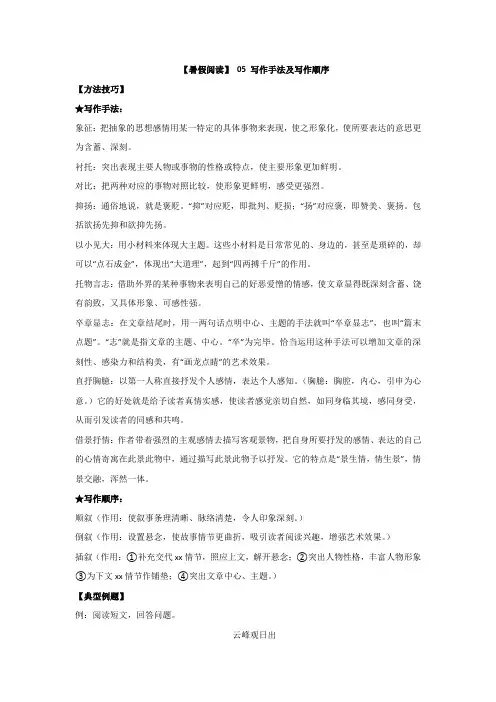
【暑假阅读】05 写作手法及写作顺序【方法技巧】★写作手法:象征:把抽象的思想感情用某一特定的具体事物来表现,使之形象化,使所要表达的意思更为含蓄、深刻。
衬托:突出表现主要人物或事物的性格或特点,使主要形象更加鲜明。
对比:把两种对应的事物对照比较,使形象更鲜明,感受更强烈。
抑扬:通俗地说,就是褒贬。
“抑”对应贬,即批判、贬损;“扬”对应褒,即赞美、褒扬。
包括欲扬先抑和欲抑先扬。
以小见大:用小材料来体现大主题。
这些小材料是日常常见的、身边的,甚至是琐碎的,却可以“点石成金”,体现出“大道理”,起到“四两搏千斤”的作用。
托物言志:借助外界的某种事物来表明自己的好恶爱憎的情感,使文章显得既深刻含蓄、饶有韵致,又具体形象、可感性强。
卒章显志:在文章结尾时,用一两句话点明中心、主题的手法就叫“卒章显志”,也叫“篇末点题”。
“志”就是指文章的主题、中心。
“卒”为完毕。
恰当运用这种手法可以增加文章的深刻性、感染力和结构美,有“画龙点睛”的艺术效果。
直抒胸臆:以第一人称直接抒发个人感情,表达个人感知。
(胸臆:胸腔,内心,引申为心意。
)它的好处就是给予读者真情实感,使读者感觉亲切自然,如同身临其境,感同身受,从而引发读者的同感和共鸣。
借景抒情:作者带着强烈的主观感情去描写客观景物,把自身所要抒发的感情、表达的自己的心情寄寓在此景此物中,通过描写此景此物予以抒发。
它的特点是“景生情,情生景”,情景交融,浑然一体。
★写作顺序:顺叙(作用:使叙事条理清晰、脉络清楚,令人印象深刻。
)倒叙(作用:设置悬念,使故事情节更曲折,吸引读者阅读兴趣,增强艺术效果。
)插叙(作用:①补充交代xx情节,照应上文,解开悬念;②突出人物性格,丰富人物形象③为下文xx情节作铺垫;④突出文章中心、主题。
)【典型例题】例:阅读短文,回答问题。
云峰观日出云峰山日出是云峰山的两大名景之一。
为了观日出,老师领着我们披着星斗,登上了云峰山顶。
虽然是夏季,但山顶仍然是凉风习习。
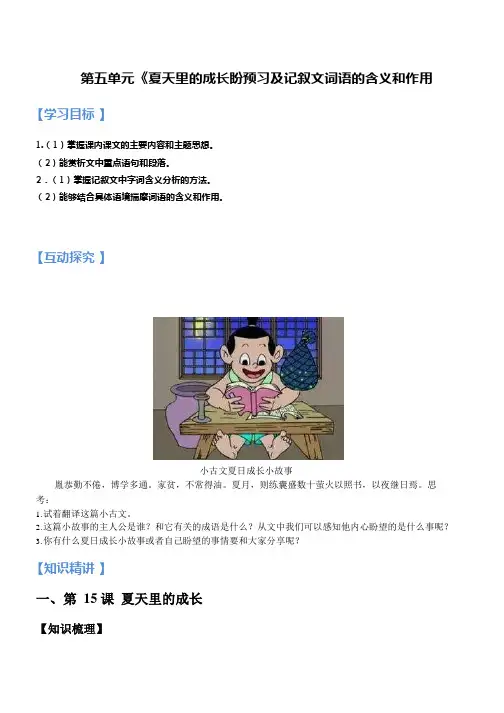
第五单元《夏天里的成长盼预习及记叙文词语的含义和作用【学习目标】1.(1)掌握课内课文的主要内容和主题思想。
(2)能赏析文中重点语句和段落。
2.(1)掌握记叙文中字词含义分析的方法。
(2)能够结合具体语境揣摩词语的含义和作用。
【互动探究】小古文夏日成长小故事胤恭勤不倦,博学多通。
家贫,不常得油。
夏月,则练囊盛数十萤火以照书,以夜继日焉。
思考:1.试着翻译这篇小古文。
2.这篇小故事的主人公是谁?和它有关的成语是什么?从文中我们可以感知他内心盼望的是什么事呢?3.你有什么夏日成长小故事或者自己盼望的事情要和大家分享呢?【知识精讲】一、第15 课夏天里的成长【知识梳理】1.【单元导语】初中阶段的读与写,本是不可分割的一个整体。
本单元的阅读,充分考虑到了写作的因素,主要学习如何围绕中心选材和组材。
本单元选了三篇文章,要求在阅读过程中,思考作者是怎样围绕中心来选取材料,表现事物特点的:《夏天里的成长》围绕“万物迅速生长的季节”,选择各种各样事物的成长,表现夏日的生机与活力;《盼》紧扣“盼”字,具体描写了“我”盼的心情;《小站》则围绕“小站”之“小”和“小”中透出的“温暖的春意”来选材、构思。
在阅读本单元的文章时,要学会概括中心,分析材料,从材料和中心的关系上探究作者的写作意图,学习围绕中心选材的思考方法和写作技巧,提高自己的写作能力。
2.【课文导读】这是一篇通过夏天万物生长的例子,阐释夏日的生机与活力的文章。
文章紧紧围绕夏季,叙写人们所熟悉的事物,如绿色植物、动物(猫狗鸡鸭等),以及自然界的河水,人筑就的铁轨、柏油路,使读者感受到世间的一切,都会随着夏天一起增长。
阅读时,要结合写作,分析作者如何确立主旨,怎样围绕主旨选材构思的。
比如,文章第 1 句“夏天是万物迅速生长的季节”,总括全文、确定本文介绍对象。
第2、3 段先说植物后说动物,使文中所表述的种种事物可亲可近。
全文紧扣特定时段“夏天”,特定规律“成长”。
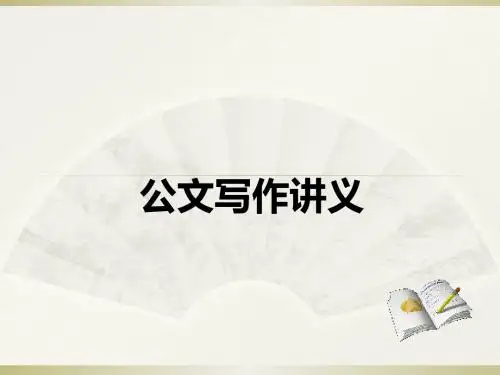
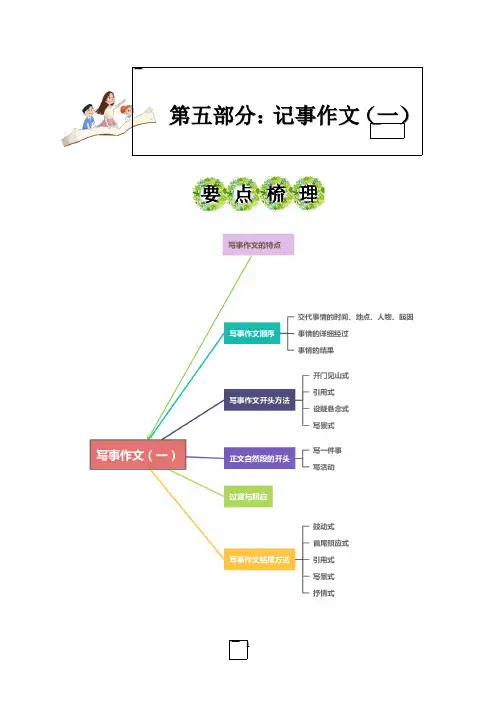
第五部分:记事作文(一)要点梳理记事作文的特点: 记事作文重点在于将记叙文的四要素或六要素时间、地点、人物、事件(事情的起因、经过、结果)叙述清楚。
记事的文章大致有两种写法,一种是只写“一件什么事”,另一种是写“活动”之类的。
对于小学生来说,只写一件事的难度要稍大一些,因为要把一件事的内容写得丰富,有些同学就会重复啰唆,平淡俗气。
写活动相对来说就要好写些,因为可抓住几个活动片段并列写好即可,但有些同学又会写得主次不分,重点不突出。
记事的作文离不开人物,所以写作时除抓住人物的语言、动作、神态和心理活动以及场面等细节的描写外,更重要的是将事情的起因、经过、结果的来龙去脉讲述清楚。
做任何事不都有个先后顺序吗只要我们按照事情的先后顺序,或时间的先后顺序,或活动场所的方位变化顺序等,把事情的起因、经过、结果写清楚,写出的作文自然条理清晰,层次分明。
(一)交代事情的时间、地点、人物、起因。
(二)事情的详细经过。
(写活动之类的可分几个并列的片段)(三)事情的结果。
记事作文的特点记事作文的顺序记事作文的开头方法文章的开头就是一篇文章的“凤头”,开头要简洁。
“万事开头难”,好的开头就是成功的一半。
字数一般控制在五十字左右。
(一)开门见山式在开头直接交代时间、地点、人物、事件的一种方法。
例如:昨天,我和妈去人民公园玩,在那里发生了一件不可思议的事。
——《我的发现》(二)引用式在开头部分引用名言、诗句、歌谣等,这种开头方法简单易掌握,虽然老套,但不俗套,适用于任何体裁的文章。
例如:我最喜欢的一句名言是“勿问成功的秘诀为何,且尽全力做你应该慢的事吧”————《我最喜欢的一句话》(三)设疑悬念式故设悬念,达到制造悬念,引起读者兴趣。
这种开头方法适用于内容新颖别致的文章。
例如:我是一个大错不犯,小错不断的孩子。
平常犯了错,爸爸妈妈、老师会念及我小,原谅我,所以我就没引起重视。
可上周二发生的一件事,我真得认为自己错了。
————《我错了》(四)写景式为文章布置环境,衬托气氛。
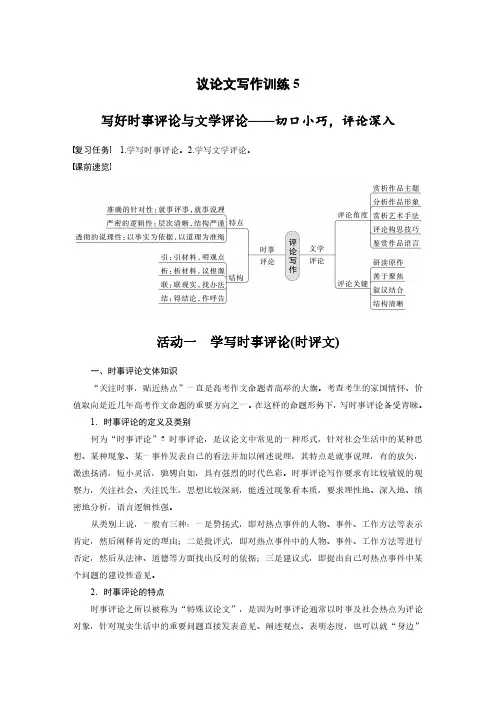
议论文写作训练5写好时事评论与文学评论——切口小巧,评论深入复习任务 1.学写时事评论。
2.学写文学评论。
课前速览活动一学写时事评论(时评文)一、时事评论文体知识“关注时事,贴近热点”一直是高考作文命题者高举的大旗。
考查考生的家国情怀、价值取向是近几年高考作文命题的重要方向之一。
在这样的命题形势下,写时事评论备受青睐。
1.时事评论的定义及类别何为“时事评论”?时事评论,是议论文中常见的一种形式,针对社会生活中的某种思想、某种现象、某一事件发表自己的看法并加以阐述说理,其特点是就事说理,有的放矢,激浊扬清,短小灵活,驰骋自如,具有强烈的时代色彩。
时事评论写作要求有比较敏锐的观察力,关注社会、关注民生,思想比较深刻,能透过现象看本质,要求理性地、深入地、缜密地分析,语言逻辑性强。
从类别上说,一般有三种:一是赞扬式,即对热点事件的人物、事件、工作方法等表示肯定,然后阐释肯定的理由;二是批评式,即对热点事件中的人物、事件、工作方法等进行否定,然后从法律、道德等方面找出反对的依据;三是建议式,即提出自己对热点事件中某个问题的建设性意见。
2.时事评论的特点时事评论之所以被称为“特殊议论文”,是因为时事评论通常以时事及社会热点为评论对象,针对现实生活中的重要问题直接发表意见、阐述观点、表明态度,也可以就“身边”事、“心头”事发表意见,因此,它具有以下鲜明的特点:(1)准确的针对性写时事评论要就事评事,就事说理,所以时事评论需要把所评之“事”交代出来,有针对性地发表评论,然后有的放矢地进行写作。
所谓“针对性”是指为什么要写,针对什么而写,要解决什么问题,希望读者能从中得到什么等,都应当十分准确。
准确的针对性是高考时事评论富有生命力的一个关键。
(2)严密的逻辑性时事评论是直接对时事进行议论,有很强的论辩色彩,因此要求逻辑严密。
在写法上,要有明确的观点、充分的论据、精练的语言、合理的论证及严密的逻辑性。
这就需要行文时注意层次,对文章诸多段落层次进行谋划和布局,先写什么,接着写什么,最后写什么,逻辑关系要非常严密,这样才能使整个内容显得严谨而和谐,才能保证文章提出的观点令人信服。
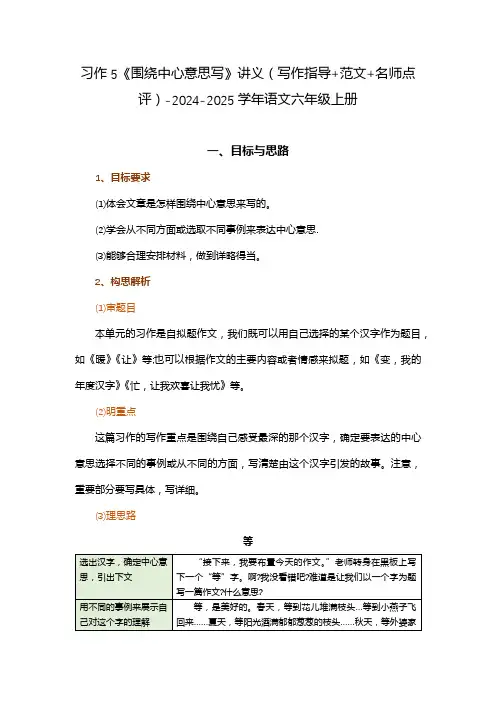
习作5《围绕中心意思写》讲义(写作指导+范文+名师点评)-2024-2025学年语文六年级上册一、目标与思路1、目标要求(1)体会文章是怎样围绕中心意思来写的。
(2)学会从不同方面或选取不同事例来表达中心意思.(3)能够合理安排材料,做到详略得当。
2、构思解析(1)审题目本单元的习作是自拟题作文,我们既可以用自己选择的某个汉字作为题目,如《暖》《让》等;也可以根据作文的主要内容或者情感来拟题,如《变,我的年度汉字》《忙,让我欢喜让我忧》等。
(2)明重点这篇习作的写作重点是围绕自己感受最深的那个汉字,确定要表达的中心意思选择不同的事例或从不同的方面,写清楚由这个汉字引发的故事。
注意,重要部分要写具体,写详细。
(3)理思路等(4)讲方法①主题突出,情感真挚我们在写作时,需要将自己的情感真实地表达出来,这样才能深化文章主题,增强文章的感染力,进而打动读者。
②)选择真实典型的素材为了更加贴切地突出主题,我们最好选择真实典型的素材,只有如此,才能恰如其地将这些事件还原,也只有在真实事例的基础上,我们才能表达出自己的真实感悟。
③围绕主题,刻画人物形象叙述事件的时候,总离不开刻画人物,而将人物在当时情境中的语言、动作、神态和心理活动表达出来,对彰显文章主题会起到至关重要的作用。
(5)选素材大家在了解了这个作文题目可以写什么以及怎么写以后,就要考虑自己的文章是选择教材给出的十二个汉字中的一个来写,还是准备用自己选的汉字来写,或者自拟哪种题目了,还要想想选什么素材来行文。
样写:我一直喜欢积木,一次相中了一款,但钱不够,没能立刻买下来。
等我生日的时候,一向大方的姑姑特意买来送给了我,我乐得直蹦,拿着积木开心了一整天。
二、教学重点与难点习作《围绕中心意思写》的教学重点与难点可以归纳如下:教学重点1.明确中心意思:帮助学生理解并明确文章的中心意思,即文章所要表达的核心主题或思想。
这是习作的基础,也是文章的灵魂。
2.多角度选材:引导学生从不同方面或选择不同的事例来支持中心意思,使文章内容更加丰富多彩,表达更加全面充分。

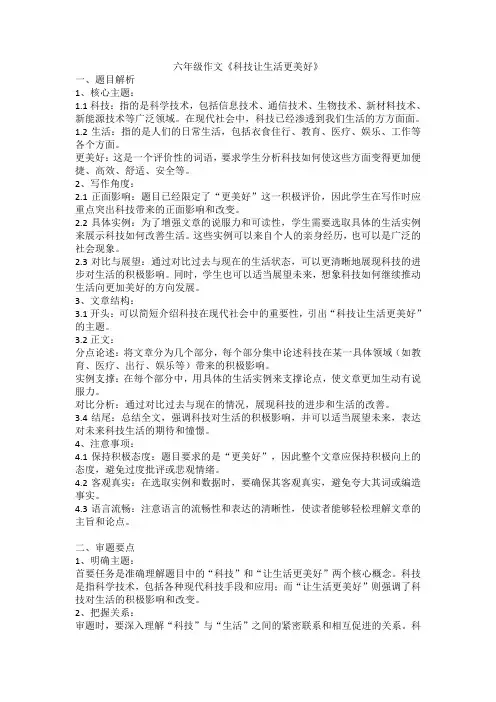
六年级作文《科技让生活更美好》一、题目解析1、核心主题:1.1科技:指的是科学技术,包括信息技术、通信技术、生物技术、新材料技术、新能源技术等广泛领域。
在现代社会中,科技已经渗透到我们生活的方方面面。
1.2生活:指的是人们的日常生活,包括衣食住行、教育、医疗、娱乐、工作等各个方面。
更美好:这是一个评价性的词语,要求学生分析科技如何使这些方面变得更加便捷、高效、舒适、安全等。
2、写作角度:2.1正面影响:题目已经限定了“更美好”这一积极评价,因此学生在写作时应重点突出科技带来的正面影响和改变。
2.2具体实例:为了增强文章的说服力和可读性,学生需要选取具体的生活实例来展示科技如何改善生活。
这些实例可以来自个人的亲身经历,也可以是广泛的社会现象。
2.3对比与展望:通过对比过去与现在的生活状态,可以更清晰地展现科技的进步对生活的积极影响。
同时,学生也可以适当展望未来,想象科技如何继续推动生活向更加美好的方向发展。
3、文章结构:3.1开头:可以简短介绍科技在现代社会中的重要性,引出“科技让生活更美好”的主题。
3.2正文:分点论述:将文章分为几个部分,每个部分集中论述科技在某一具体领域(如教育、医疗、出行、娱乐等)带来的积极影响。
实例支撑:在每个部分中,用具体的生活实例来支撑论点,使文章更加生动有说服力。
对比分析:通过对比过去与现在的情况,展现科技的进步和生活的改善。
3.4结尾:总结全文,强调科技对生活的积极影响,并可以适当展望未来,表达对未来科技生活的期待和憧憬。
4、注意事项:4.1保持积极态度:题目要求的是“更美好”,因此整个文章应保持积极向上的态度,避免过度批评或悲观情绪。
4.2客观真实:在选取实例和数据时,要确保其客观真实,避免夸大其词或编造事实。
4.3语言流畅:注意语言的流畅性和表达的清晰性,使读者能够轻松理解文章的主旨和论点。
二、审题要点1、明确主题:首要任务是准确理解题目中的“科技”和“让生活更美好”两个核心概念。
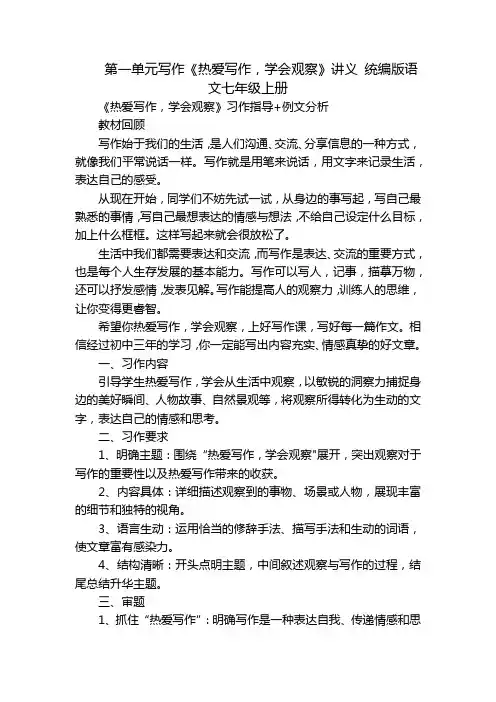
第一单元写作《热爱写作,学会观察》讲义统编版语文七年级上册《热爱写作,学会观察》习作指导+例文分析教材回顾写作始于我们的生活,是人们沟通、交流、分享信息的一种方式,就像我们平常说话一样。
写作就是用笔来说话,用文字来记录生活,表达自己的感受。
从现在开始,同学们不妨先试一试,从身边的事写起,写自己最熟悉的事情,写自己最想表达的情感与想法,不给自己设定什么目标,加上什么框框。
这样写起来就会很放松了。
生活中我们都需要表达和交流,而写作是表达、交流的重要方式,也是每个人生存发展的基本能力。
写作可以写人,记事,描摹万物,还可以抒发感情,发表见解。
写作能提高人的观察力,训练人的思维,让你变得更睿智。
希望你热爱写作,学会观察,上好写作课,写好每一篇作文。
相信经过初中三年的学习,你一定能写出内容充实、情感真挚的好文章。
一、习作内容引导学生热爱写作,学会从生活中观察,以敏锐的洞察力捕捉身边的美好瞬间、人物故事、自然景观等,将观察所得转化为生动的文字,表达自己的情感和思考。
二、习作要求1、明确主题:围绕“热爱写作,学会观察"展开,突出观察对于写作的重要性以及热爱写作带来的收获。
2、内容具体:详细描述观察到的事物、场景或人物,展现丰富的细节和独特的视角。
3、语言生动:运用恰当的修辞手法、描写手法和生动的词语,使文章富有感染力。
4、结构清晰:开头点明主题,中间叙述观察与写作的过程,结尾总结升华主题。
三、审题1、抓住“热爱写作”:明确写作是一种表达自我、传递情感和思想的方式,要培养对写作的热爱之情。
2、明确“学会观察":认识到观察是写作的基础,通过仔细观察生活中的点点滴滴,为写作提供丰富的素材。
3、注意“两者关系”:理解热爱写作与学会观察之间的相互促进作用,观察能激发写作灵感,写作能深化观察体验。
四、选材和构思1、选材:自然景观:如日出日落、四季变化、山川河流等,描写大自然的美丽与神奇。
人物故事:身边的家人、朋友、陌生人等,展现人物的性格、情感和经历。
Contents of the Academic Writing CourseLesson 1: Course IntroductionLesson 2-3: Features of Academic WritingLesson 4:Taking Notes and OutliningLesson 5:Writing AbstractLesson 6:Writing IntroductionLesson 7:Writing ConclusionLesson 8:Avoiding PlagiarismLesson 9:Citing SourcesLesson 10: ParaphrasingLesson 11: SummarizingLesson 12: ReportingLesson 13-14: DocumentationLesson 15: ProofreadingLesson 16: Oral DefendingLesson 1: Course Introduction1. Academic Writing requires you to:To evaluate or interpret or in some other way add to and participate in what you writeTo consider the why and how of the topic you choose.To develop a point of view toward your material, take a stand, express some original thought.To analyze, interpret, evaluate the information you gather, and then to draw conclusions from it. 2. Qualities a research paper has:It is defined by a clear audience, a clear purpose and a clear structure.It is a work that shows your originality.It acknowledges all sources you have used.3. Four steps to write an academic essaya. Choosing and narrowing a topicb. Doing the research and readingc. Planning and writing various draftsd. Proof-reading and editingHow to choose a topic?Decide on your research direction:A. Literature is prose, written or oral, including fiction and non-fiction, drama and poetry. Research in literature can be a study of a particular author, a work, or a literary trend.It can also include comparative research of different writers, books, or literary criticisms.B. Translation is the interpreting of the meaning of a text and the subsequent production of an equivalent text that communicates the same message in another language.Research in translation can be an evaluation of the translation of a particular work or an author.It can also include research on a particular translator and his/her translations.It may also include research on translation techniques and theories.C. Linguistics is the study of language.Sub-areas:Phonetics/ Phonology 语音Syntax 句法Semantics 语义学Pragmatics 语用学Language and Socio-CultureLanguage learning and teachingSelecting a General TopicLiterature : which novel or play? which author?Translation : which source text or writer? which translator?Linguistics : which sub-area?Culture: which aspect?The Rule of the Thumb:your interest;your audience’s interest;your knowledge;availability of ample references;freshnessReading and ThinkingAn essay usually draws on common knowledge from a limited or personal point of view.A research paper is based on a thorough review of various sources and document the sources of information.Narrowing down the Scope of TopicNarrowing your topic should be depends on the purpose and length of your research paper. E.g. “An Analysis of Happy Marriages of Three Women in Emma”An Analysis of Emma;An Analysis of Three Women in Emma;An Analysis of Happy Marriages of Three Women in EmmaFormulating the Final TopicCriteria for the final topic:(1) It should be meaningful and serious;(2) It should be within the range of your abilities;(3) It should have sufficient materials available;(4) It can be treated objectivelyL2-3 Features of AWComplexityWritten language is lexically more dense: more noun-based phrases, more nominalizations, and more lexical variation.Written language is grammatically more complex: more subordinate clauses, more "that/to" complement clauses, more long sequences of prepositional phrases, more attributive adjectives and more passives.Formality1) Try to use full forms, avoid contractions. e. g. Don’t should be do not2) Use single-word verbs, avoid phrasal verbs wherever possible because phrasal verbs are generally more colloquial and informal than single word verbs. e.g. instead of using “bring up”we use “raise”3) Use standard or formal words and expressions, avoid informal or nonstandard words and expressions such as colloquialism, slang, and taboo words and expressions.e. g. Informal words formal wordsleave departquit resigntired fatiguedflunk faillab laboratory4) Use concrete words and expressions, avoid vague or imprecise terms. Words like thing, bit should be banned.e.g. Several things must be borne in mind when evaluating EFL textbooks.Improved: Several points must be considered when evaluating EFL textbooks.Objectivity1) Avoid the first person pronoun “I”and the second person pronoun “you”. Always use the third person references, like “the writer, the present author, or this author”.e.g. Don't write: "You can easily forget how different life was 50 years ago."Write: "It is easy to forget how difficult life was 50 years ago."2) When expressing an opinion or belief, try to use impersonal constructions.e.g. you can see--- it can be seen thatI believe --- it is commonly believed thatI hear --- it is saidConciseness1)Find the most direct way to express the idea. Use as few words as possible.2)Avoid repetition of ideas.3)Concentrate on the topic. Anything that is irrelevant and unnecessary, no matter how well written, should be deleted.4). Be precise and specific---reduce unnecessary words5. Hedging: tentative language1)It is often believed that academic writing is factual, simply to convey facts and information. However it is now recognized that an important feature of academic writing is the concept of cautious language, often called "hedging" or "vague language".2)Use affirmative structures only when there is complete certainty.e.g. It is true that…it has been proved that…3) Use tentative structures if there is no complete certainty. Modal verbs, adverbs, and other expressions often help to achieve this purpose.e.g. It is commonly accepted that…There is evidence to suggest that ….The author tends to believe that….Languages used in hedging:Introductory verbs e.g. seem, tend, appearCertain lexical verbs e.g. assume, suggestCertain modal verbs e.g. will, must, wouldAdverbs of frequency e.g. often, sometimesModal adverbs e.g. certainly, definitelyModal adjectives e.g. certain, definite, clear, probableModal nouns e.g. assumption, possibilityThat clauses e.g. It could be the case that…To-clause + adjective e.g. It may be possible to obtain.ResponsibilityIn academic writing you must be responsible for, and must be able to provide evidence and justification for, any claims you make.You are also responsible for demonstrating an understanding of any source texts you use. Examples&ExercisesL4. Taking Notes and OutliningTaking Notes- three principlesKnow what kind of ideas you need to recordDon't write down too muchLabel your notes intelligentlyWays of taking notes1) Keeping your notes on separate cards keeps you from relying too heavily on one source, it is also a flexible way of recording information because they can be easily sorted.2) On each card identify the source by a short name, and note the page number; give each listing a simple descriptive heading.3) Compare your notes to your outline regularly to determine where you have accumulated enough support and where you still need to find more.3. Main Components for Effective Outline1). Parallelism: Each heading and subheading should preserve parallel structure. If the first heading is a verb, the second heading should be a verb.e.g.3.1 Chinglish in pronunciation3.2 Chinglish in words and expressions3.3 Chinglish in word order3.4 Chinglish in grammar3.5 Chinglish in conventionCoordination : All the information contained in Heading 1 should have the same significance as the information contained in Heading 2. The same goes for the subheadings (which should be less significant than the headings)Subordination: The information in the headings should be more general, while the information in the subheadings should be more specific.e.g.Chapter Three Questionnaire or Investigation of English Majors in Independent College and Results Analysis3.1 Chinglish in pronunciation3.2 Chinglish in words and expressions3.2.1 Unnecessary words3.2.2 Misused words3.2.3 Incorrect subjects3.3 Chinglish in word order3.4 Chinglish in grammar3.5 Chinglish in conventionForms of an Outline: The most important rule for outlining form is to be consistent! An outline usually uses topic structure. A topic outline uses words or phrases for all entries and uses no punctuation after entries.E.g. Chapter Two Shakespeare’s Early life in Stratford2.1. Shakespeare's family2.1.1. Shakespeare's father2.1.2. Shakespeare's mother2.2. Shakespeare's marriage2.2.1. Life of Anne Hathaway2.2.2. Reference in Shakespeare's PoemsL5 Writing AbstractsFeatures of an Abstract:Brevity: to covey in as few words as possible the essential information contained in the paper you have written.Objectiveness: to state objectively your own ideas and main points in the paper.Integrity: to confine the abstract to a single paragraph with limited words (within 200-300) and necessary elements of information.Concentration: to omit such elements of information as figures, tables, or literature references in a summary or abstract, to avoid repeating the unnecessary elements that conventionally appear in other sections of the paper.Consistency: to be consistent with the other parts of the whole paper, and never to include what has not been mentioned in the paper.Completeness: to include what you have done and what you have achieved within the scope of the topic, such as the research theories, research methods, investigations and results and conclusions, and to differentiate your paper work from others by stressing this paper‟s contribution.2. Typical Organization of an abstract:Part One: Introduction---to define the context, the argument, the purpose of the present studyPart Two: Contents of the study --- to outline the main participants, the methods and the procedures of the study.Part Three: Results, findings and conclusion --- to present the most important results and related findings, and give suggestions of further study.3. Example of an abstractThe focus of this research is in the area of... Such a study is important in order to.... The research approach adopted in this dissertation includes... The findings from this research provide evidence that…The main conclusions drawn from this study are... This dissertation recommends that…Keywords: a, b, c, d, e4. How to choose key words:a. high frequency in the thesisb. focus of the thesisRequirements:a. noun formb. 3-5 words with semicolons in the middlec. without capitalization of the first wordd. under the Abstract textL6 Writing Introduction1. Purposes of introductionTo show your reader what you are doing in your writing(establish the context of the research)To explain why you are doing it (state the purpose of the essay)To explain how you are doing it (briefly explain your rationale and approach and the possible outcomes your study can reveal)2. Parts of an introductionEstablish a research territoryIndicate a gapOccupy the gap3. Languages of each part:Establish a research territory:The increasing interest in ... has heightened the need for ....Of particular interest and complexity are ....Recently, there has been growing interest in ....(2) Indicate a gap:The research has tended to focus on ...,rather than on ....These studies have emphasized ...,as opposed to ....Although considerable research has been devoted to ... , rather less attention has been paid 33to ....(3) Occupy the gap:The purpose / intention of this paper is to ...The primary goal / aim of this research is to ...The overall objective of this study is…This paper reports on the results obtained ....This study was designed to ...3. Frequently asked questions:How long should an introduction be?How detailed should an introduction be?Why is it so hard to write an introduction?What is an introduction for? Is it a summary?What should I put in my introduction?How many paragraphs should I write for the introduction?In a word,You can't write a good introduction until you know what the body of the paper says.Consider writing the introductory sections after you have completed the rest of the paper, rather than before.L7. Writing Conclusion1. Structure:1)Link to previous paragraph: Begin with a sentence that refers to the main subject that was discussed in the body in the essay. Make sure that this sentence also links to the preceding paragraph, or uses words such as In conclusion to signal that these are your final words on the subject.2)Brief summary: you may give a brief summary of your argument and identify the main reasons/causes/factors that relate to the question you have been asked to address. If there are two or more parts to the question, be sure to include responses to each part in your conclusion.3)Reinforce the thesis statement: it is a good idea to add a sentence or two to reinforce the thesis statement which was used in your introduction. This shows the reader that you have done what you said you would do and gives a sense of unity to the essay.4)Recommendations/speculations on future action: Additional elements that may be added include recommendations for future action and speculations on future trends. Generally, although a short pithy quote can sometimes be used to spice up your conclusion, the conclusion should be in your own words. Try to avoid direct quotations, or references to other sources.e.g.It is generally/widely accepted/argued/held/believed/that…In conclusion/it can/may be said that…An important direction for further work might be to study …Further studies should focus on the practical use of …A further experiment should be conducted with …[ a new research method] in order to generalize the effect of …Lesson 8 Avoiding Plagiarism1. Definition of plagiarism:Plagiarism is defined as the unacknowledged use, as one‟s own, of work of another person, whether or not such work has been published.Put it simply, plagiarism is copying the work of another person without proper acknowledgement. There are two parts in the definition:1 copying2 absence of proper acknowledgement2. The term of proper aknowlegementPlagiarism does not mean that you cannot quote f rom others‟ work.The aim of University education is to foster your originality, your independent thinking and analysis, your power to express and convey your own ideas.You are free to quote the work of others to strengthen your arguments provided that the quote is properly identified and t h e s o u r c e i s a c k n o w l e d g e d.3.Forms of plagiarism:Turning in someone else‟s work as your ownCopying words or ideas from someone else without giving creditFailing to put a quotation in quotation marksGiving incorrect information about the source of a quotationChanging words but copying the sentence structure of a source without giving credit.Copying so many words or ideas from a source that it makes up the majority of your work, whether you give credit or notLesson 9 Citing Sources1. Ways of citing sourcesa)Reporting: to report the other writer's ideas into your own words. You can either paraphrase if you want to keep the length the same or summarize if you want to make the text shorter.b) Direct Quotation: to quote another author's words exactly. You have to make it very clear that the words or ideas that you are using are taken from another writer.2. Direct quotationTaking the exact words from an original source is called quoting. You should quote material when you believe the way the original author expresses an idea is the most effective means of communicating the point you want to make. If you want to borrow an idea from an author, but do not need his or her exact words, you should try paraphrasing instead of quoting.3. How much should I quoteConsider quoting a passage from one of yoursources if any of the following conditions holds: The language of the passage is particularly elegant or powerful or memorable.You wish to confirm the credibility of your argument by enlisting the support of an authority on your topic.The passage is worthy of further analysis.You wish to argue with someone else's position in considerable detail.4. Languages in direct quotationAs X said/says, "... ..."As X stated/states, "... ..."As X wrote/writes, "... ..."As X commented/comments, "... ..."As X observed/observes, "... ..."As X pointed/points out, "... ..."To quote from X, "... ..."It was X who said that "... ..."This example is given by X: "... ..."Lesson10 Paraphrasing1. What is paraphrasingParaphrase=para (modifying) + phrase (tell)To paraphrase means to completely reproduce the original meaning in our own words (but never include our own opinion).2. Three essentials of paraphrasingB ecause you are using someone else‟s words and ideas, you must be sure to do the following:(1) Represent the writers‟ views accurately. Don‟t distort the original meaning.(2) Use quotation marks – identify any unique words or phrases that appear in the original.(3) Cite in-text – By referring to the example above, provide a reference on your reference page so that the reader will know where to find the original that you are paraphrasing.3. Strategies of paraphrasing1) Read and understand the text.2) Make a list of the main ideas.3) Change the structure of the text4) Change the grammar and vocabulary5) Rewrite the main ideas in complete sentences; combine your notes critically6) Check your workLesson 11 Summarizing1. Structural features of a summaryA summary is a short version of a longer text, and it gives only the main points.Short sentences are normally required, but numbered points and/or other graphic devices may also be used.The length of a summary varies according to its purpose; however, it should generally be no more than one-third the length of the original.2. Stages of writing a summary1) Read and understand the text carefully.2) Think about the purpose of the text.Ask what the author's purpose is in writing the text?What is your purpose in writing your summary? Are you summarizing to support your points? Or are you summarizing so you can criticize the work before you introduce your main points?3) Select the relevant information. This depends on your purpose.4) Find the main ideas - what is important.They may be found in topic sentences.Distinguish between main and subsidiary information.Delete most details and examples, unimportant information, anecdotes, examples, illustrations, data etc.Find alternative words/synonyms for these words/phrases - do not change specialized vocabulary and common words.5) Change the structure of the text.Identify the meaning relationships between the words/ideas - e.g. cause/effect, generalization, contrast. Express these relationships in a different way.Change the grammar of the text: rearrange words and sentences. Change nouns to verbs, adjectives to adverbs, etc., break up long sentences, combine short sentences.6) Simplify the text. Reduce complex sentences to simple sentences, simple sentences to phrases, phrases to single words.Lesson 12 Reporting1. What is synthesisA synthesis is a combination, usually a shortened version, of several texts made into one. It contains the important points in the text and is written in your own words. To make a synthesis you need tofind suitable sourcesselect the relevant parts in those sources.use your paraphrase and summary skills to write the information in your own words. The information from all the sources has to fit together into one continuous text.Test on ReportingLesson 13-14 Documentation1. In-text References1) Citing one workBy one or two authors:Author‟s surname in main sentence: year of publication in parenthesese.g. More recent work by Troy (2005) has provided support for the notion that memory for faces involves verbal as well as visual information.b. Author not named in main sentence: author‟s surname and year of publication in parentheses, separated by commae.g. It has been argued that teachers‟ role is to provide the students with optimal conditions which can facilitate learning so that students can achieve similar successful results (Bryman & Cramer, 1990).B. By more than two but fewer than six authors: cite the surnames of all the authors the first time the reference appears in text. In subsequent citations, you simply cite the surname of the first author followed by “et al.”e.g. Studies of the good language learner ( for example, Naiman, Frohlich, Stern and Todesco, 1978) have tried to identify the strategies which successful learners use (Ellis, 1994, p.37). (first citation)Naiman et al. (1978) found a similar relationship, although in this case …effort‟ on the part of the learners was also associated with instrumental motivation (Ellis, 1994, p.512).(subsequent citations)C. By six or more authors: cite the surname of the first author followed by “et al.” for the first and subsequent citations.2) Citing two or more works:A. By the same author: give the surname once, then the years of publication from past to the present. e.g.Empirical studies on student learning carried out since the 70s have found that students‟ learning outcomes to a great extent depend on their choice of learning approaches (Biggs, 1979, 1987). B. By different auth ors: arrange the citations in alphabetical order by the first author‟s surnamee.g. One major finding from the earlier studies (Barley, 1969, 1970; Clement et al., 1978; Gardner & Lambert, 1972; Spolsky, 1969) was that learners with an integrative motivation tended to obtain better achievement than those with an instrumental motivation.3) Citing an Indirect "Second-hand" SourceRemember that you can't treat a source like you have it in hand unless you actually have it in hand. If you want to cite an idea or quote which one of your sources uses, you need to indicate that this is a "second-hand" source by showing in your citation that this information is quoted in (qtd. in) the source you actually have in hand.e.g. Peterkin (1978), for instance, envisioned the black folk as sufferers in "a patient struggle with fate, and not in any race conflict at all" (qtd. in Clark, 1989, p.219).Reference List1)Use heading: References/Bibliography2)Use square brackets instead of parenthesis.3)Page numbers should be included for all articles in journals and in collections.4)Use italics (or underlining in handwriting) for titles of books, periodicals, newspapers etc.5)Use alphabetical order.6)All co-authors should be listed.7)If the author of a document is not given, begin the reference with the title of the document.(1) English ReferencesA. Booksa. One author:[1] Smith, F. (1978). Reading. Cambridge: Cambridge University Press.b. Two authors:[2] Fromkin, V. & Rodman, R. (1983). An Introduction to Language. London: Holt-Saunders.c. More than two authors:[3] Barr, P., Clegg, J. & Wallace, C. (1981). Advanced Reading Skills. London: Longman.d. Book, no author, or editor:[4] Longman Dictionary of Contemporary English. (1978). London: Longman.e. Edited collections:[5] Kinsella, V. (Ed.). (1978). Language Teaching and Linguistics: Surveys. Cambridge:Cambridge University Press.[6] Oller, J. W. & Richards, J. C. (Eds.). (1973). Focus on the Learner. Rowley, Massachusetts:Newbury House.f. Book, corporate author:[7] British Council Teaching Information Centre. (1978). Pre-sessional Courses for OverseasStudents. London: British Council.g. Book, third edition:[8] Fromkin, V. & Rodman, R. (1983). An Introduction to Language (3rd ed.). London:Holt-Saunders.h. Book, revised edition:[9] Cohen, J. (1977). Statistical Power Analysis for the Behavioural Sciences (rev.ed.). New York:Plenum Press.i. Books or articles, two or more by the same author in the same year:[10] Lyons, J. (1981a). Language and Linguistics. Cambridge: Cambridge University Press.[11] Lyons, J. (1981b). Language, Meaning and Context. London: Fontana.B. Periodical Articlesa. One author:[1] Abercrombie, D. (1968). Paralanguage. British Journal of Disorders of Communication, 3,55-59.b. Two authors:[2] Lipinsky, E. & Bender, R. (1980). Critical Voices on the Economy. Survey, 25, 38-42.c. More than two authors:[3] Guiora, A. Z., Paluszny, M., Beit-Hallahmi, B., Catford, J. C., Cooley, R. E. & Dull, C. Y.(1975). Language and Person: Studies in Language Behaviour. Language Learning, 25, 43-61.d. Magazine article:[4] Gardner, H. (1981, December). Do Babies Sing a Universal Song. Psychology Today, 70-76.e. Newspaper article:[5] James, R. (1991, December 15). Obesity Affects Economic Social Status. The Guardian, p. 18.C. Selections from edited collectionsa. One author:[1] Chomsky, N. (1973). Linguistic Theory. In Oller, J.W. & Richards, J.C. (Eds.), Focus on theLearner (pp. 29-35). Rowley, Massachusetts: Newbury House.b. Two authors:[2] Stern, H. H. & Weinrib, A. (1978). Foreign Languages for Younger Children: Trends andAssessment. In Kinsella, V. (Ed.), Language Teaching and Linguistics: Surveys (pp. 152-172).Cambridge: Cambridge University Press.Chinese References中文参考资料需要标注类型: [J]代表期刊, [M]代表专著,[A]代表论文集中的论文, [C]代表论文集, [Z]代表其他类型的文献。
小学三年级作文培训讲义小学中年级作文培训资料姓名年级第一讲写人部分训练目标通过鲜明的个性描写来展现自己的性格特点。
训练指导1第一次写自己写自我的作文就是抓住自己的动作、语言、外貌、心理以及一些细节描写来刻画自己的性格特点,展现自己性格中好的一面,如:文静可爱、天真活泼、聪明伶俐;或是不好的一面:脾气暴躁、马虎大意、顽皮好动等特点,选择自己比较独特的区别于他人的特征重点来写,写时要采用第一人称“我”来写。
练笔积累好词:1)性格方面:聪明、马虎、好动、文静、勇敢、调皮、活泼、胆小2)眼睛方面:水汪汪、水灵灵、黑宝石、炯炯有神、的3)发型方面:齐肩的短发、齐眉的刘海、长长的辫子、两个羊角辫、一个头、后脑勺留着个小辫子……4)脸型方面:瓜子脸、椭圆形脸、圆圆的脸、长长的脸、胖乎乎的脸5)个别特征:两个深深的酒窝、下巴上一颗黑痣……好句:站在你面前的是一个文静的小女人,她梳着两条长长的辫子,长着一张瓜子脸,一双水汪汪的大眼睛长在弯弯的眉毛下面,平常爱说爱笑,一笑就露出一口白牙,脸上还露出两个深深的酒窝呢。
写作提纲:我第一段:介绍自己的外貌特点。
第二段:写自己的优缺点、性格特点,展现一个真实的自我(如:喜欢看书、喜欢看电视、关心别人、热爱劳动、做作业粗心……)第三段:用一两句话总结自己。
2第二次写一个熟悉的人训练目标训练学生通过一两件具体事例,写出人物特点来;研究通过人物外貌、语言、动作等描写3突出人物特点的方法。
锻炼指导外貌描写也叫肖像描写。
主要是把人物的外形特征:容貌、身材、衣着、神情、姿态、风度等描写出来。
准确而传神的外貌描写能使人物形象更加鲜明,性格更加突出,这就要求我们在平时生活中要善于观察、勤于思考。
练笔积累品质:助人为乐、大公无私、热爱劳动、工作负责……性格:倔强、爱发脾气、好强、爱说爱笑……兴趣爱好:爱唱歌、爱集邮、爱踢球、爱种花……好句:1)矮矮的个头,一张白嫩嫩的脸,大眼睛总是目不转睛地盯着老师讲课,别看她的个子不高,可是做什么事总要弄个明白,她被数学题难住了,只见她眉头紧锁,最终她的眼泪像珍珠一样滑落下来,唉,她太爱哭啦。
写作高频词汇替换❝认为:❝常用词汇:think❝替换词汇:argue,claim,believe,consider,point out,regard,contend,advocate,deem,be convinced,hold the opinion that,❝很,非常:❝常用词汇:very❝替换词汇:dramatically,considerably,enormously,tremendously,remarkably❝发生:❝常用词汇:happen❝替换词汇:occur, take place, arise, appear, emerge❝人们:❝常用词汇:people/person❝替换词汇:individuals,citizens,public,folks,the masses ❝普遍:❝常用词汇:common/popular❝替换词汇:general, universal, rife, widespread, pervasive, prevalent❝重要:❝常用词汇:important❝替换词汇:significant,crucial,essential,vital,imperative ❝不同的:❝常用词汇:different❝替换词汇:distinctive,dissimilar, diverse, assorted❝许多:❝常用词汇:many /much❝替换词汇:considerable,multitudinous,myriad ,numerous,various,a large number of❝喜欢:❝常用词汇:like❝替换词汇:appreciate,fond of,enjoy,prefer,favor❝严重:❝常用词汇:serious❝替换词汇:grave,fearful,grisliness,severe❝方法:❝常用词汇:way❝替换词汇:means,measure,method,avenue,approach ❝部分:❝常用词汇:part❝替换词汇:component fraction portion section segment❝包括:❝常用词汇:include❝替换词汇:contain,cover,embody,comprise,consist,involve❝导致:❝常用词汇:cause/ lead to❝替换词汇:bring on,conduce,induce reflect on,result in ❝越来越:more and more❝修饰名词:❝more and more + 名词复数;❝=名词复数+ in growing numbers❝修饰副词:❝more and more +形容词❝=increasingly +形容词❝例句:越来越多的人认为健康很重要。
寒假大语文系统直播课【写作二】三言,两语,一生姓名:_______________________日期:_______________________版块一:工欲善其事一、梗概不是缩句我们这节课的主要目标是要写出一本书的故事梗概。
有同学一看就懵了:老师,那可是一整本书呀!这得写多少字啊!别急,我们一点一点来,首先,我们来写几个长句子的梗概。
注意,我们在这里用的词是【写梗概】而不是【缩句】。
参照样例,尝试完成以下任务,说一说,【写梗概】和【缩句】有什么区别?感觉到了吗?现在自己来做个题试一试材料1:他讨厌教堂里牧师毫无趣味的说教,也不喜欢学校里枯燥无味的生活。
缩句:_____________________________________________梗概:_____________________________________________感受到梗概的神奇之处在哪里了吗?梗概,在现代汉语词典的解释是“大略的内容”。
这个概念太宽泛了。
现在我们一起来总结一下,和缩写相比,梗概都有哪些特征。
二、别急,一步一步来现在我们弄明白了缩写和梗概的区别,并且尝试写了一个句子的梗概。
现在,我们来试着写一小段文字的梗概。
材料2:毛主席舀了两碗水送到她们母女俩手里,说:“你们俩歇会儿吧!”然后对警卫员说:“来,咱俩试试,半年多不推这玩意儿了。
”毛主席推碾子还挺在行,一边推,一边还用笤帚往碾盘里扫碾出来的玉米碎粒。
梗概:____________________________________________________材料3:第一批种子没有成长,我很快知道,是由于干旱。
我又找了一片更潮湿的土地,做了第二次尝试。
我在我的新凉亭附近,开垦出一块地,在二月份播下了种子。
那是春分前几天。
因为有三月和四月的雨水灌溉,秧苗长得非常喜人,长出很多稻穗和麦穗。
但是因为播的是剩余的种子,而且没敢全种上,最后到手的粮食并不多。
米麦收成各自不到半配克。